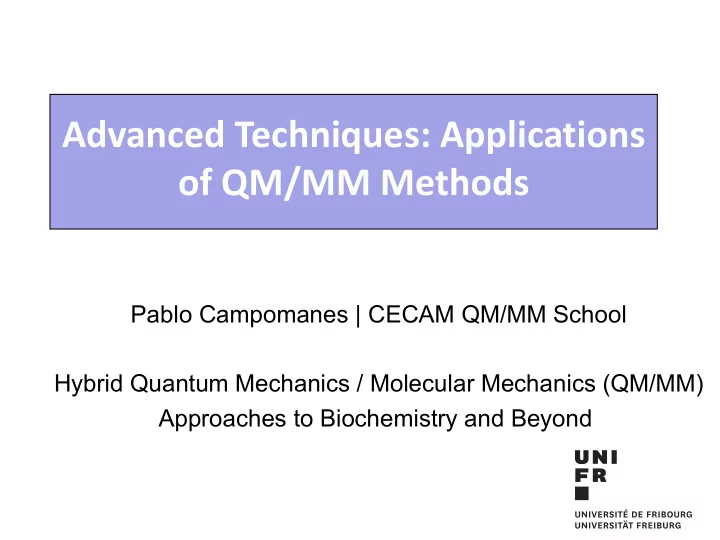

Advanced Techniques: Applications of QM/MM Methods Pablo Campomanes | CECAM QM/MM School Hybrid Quantum Mechanics / Molecular Mechanics (QM/MM) Approaches to Biochemistry and Beyond
In which scenarios QM/MM is useful? When this method is the best/unique option? QM part : ü DFT ü e- play key role MM part : ü Classical force field ü Environmental effects
Main limitations of QM/MM? How to overcome them? The sampling bottleneck Fast oscillations around each minimun Slow jumping over the barrier
Main limitations of QM/MM? How to overcome them? Beyond standard QM/MM techniques q Blue Moon Ensemble (Thermodynamic Integration) q Metadynamics Accelerated Schemes
Chemical Reactivity: Binding of Ru- based drugs to the Nucleosome Core Particle
Ru-based drugs: Chemical structure and properties [(η6- p cymene)Ru(ethylenediamine)Cl]PF6 [(η6- p cymene)Ru(1,3,5-triaza-7-phosphaadamantane)Cl2] Activated through hydrolysis inside cells (low [Cl - ]) Present low toxicity and high selectivity Inactive against primary tumors Cytotoxic anti-primary tumor activity Inactive against metastases Active against metastases Different intracellular targets Both can bind to naked DNA and isolated proteins
Selective Binding of Ru(II) drugs (histone .vs. DNA)
Ru(II) metallo-drugs Binding: Reaction Coordinate
Ru(II) metallo-drugs Binding: Reaction Coordinate
Main keywords to include in CP2K input file &FORCE_EVAL &MOTION &SUBSYS &CONSTRAINT &COLVAR !COLVAR 1 &DISTANCE &COLLECTIVE ATOMS 217 258 COLVAR 1 &END DISTANCE INTERMOLECULAR TRUE &END COLVAR TARGET [angstrom] 3.4 &END COLLECTIVE &LAGRANGE MULTIPLIERS ON &END LAGRANGE MULTIPLIERS &END CONSTRAINT
Ru(II) metallo-drugs Binding: Reaction Mechanism
Ru-arene metallo-drugs Binding: PMF profiles from TI
RAED-C binding: Critical structures & Free energies Nature Comm. , 5 , 3462 (2014)
RAPTA-C binding: Critical structures & Free energies Nature Comm. , 5 , 3462 (2014)
Ru-based drugs: Chemical structure and properties [(η6- p cymene)Ru(ethylenediamine)Cl]PF6 [(η6- p cymene)Ru(1,3,5-triaza-7-phosphaadamantane)Cl2] Different intracellular targets YES Accessible histone sites on the surface of the nucleosome, steric constraints in the double helix pose an obstacle towards accommodating two bulky ligands in the case of RAPTA-C Development of new Ru drugs with “ad hoc” cytotoxic properties, via ligand-based modulation of DNA versus protein binding
Enzymatic reactivity Catalases .vs. Peroxidases
Mode of action of catalases .vs. peroxidases Protective role : catalyze peroxidic bond heterolytic cleavage in H 2 O 2 ü Avoid accumulation of ROS ü Regulate ROS in signaling pathways
Catalases .vs. peroxidases - Previous studies Cpd I reduction is rate-determining step
Catalases .vs. peroxidases – Active site differences catalases peroxidases “QASR” Knowledge of mechanism of Cpd I Rational engineering of peroxidases with reduction by H 2 O 2 in catalases higher activity vs. H 2 O 2 disproportionation
QM/MM MD simulations (CP2K) Quartet spin state His42 BLYP/TZV2P GTH pseudopotentials Arg38 Pro139 320 Ry cutoff BO dynamics NVT ensemble His170 0.5 fs timestep AMBER ff. for MM part
Metadynamics: accelerating � rare events � Rare events : Events that happen on a very long time scale Special techniques must be used • Identification of a small number of CVs able to describe the activated process of interest (reduced dimensionality) • The dynamics in the CV space is driven by the addition of a history-dependent potential term constructed by the addition of gaussians centered along the trajectory
Collective Variables (O 2 formation) CV1: CN from O(peroxide) to H(peroxide) CV2: CN from O(oxoferryl) to H(peroxide)+H(wat) (H 2 O 2 formation) Δs CV1 = 0.05 Δs CV2 = 0.08 W = 0.6 kcal/mol t MTD = 15 fs J. Am. Chem. Soc. , 137 , 11170 (2015)
Main keywords to include in CP2K input file &FORCE_EVAL &SUBSYS &COLVAR !COLVAR 1 &COORDINATION ATOMS_FROM 40 41 ATOMS_TO 42 43 R0 [angstrom] 1.00 NN 12 ND 15 &END COORDINATION &END COLVAR &COLVAR !COLVAR 2 &COORDINATION ATOMS_FROM 46 ATOMS_TO 42 43 86 87 R0 [angstrom] 1.80 NN 3 ND 6 &END COORDINATION &END COLVAR
Main keywords to include in CP2K input file &MOTION &FREE ENERGY METHOD METADYN &METADYN DO_HILLS NT_HILLS 30 WW 0.001 Δs CV1 = 0.05 &METAVAR COLVAR 1 Δs CV2 = 0.08 WIDTH 0.05 W = 0.6 kcal/mol &END METAVAR t MTD = 15 fs &METAVAR COLVAR 2 WIDTH 0.08 &END METAVAR &END METADYN &END FREE ENERGY
Mechanism for Cpd I reduction in peroxidases
Free Energy Profile for Cpd I reduction in HRP 2H 2 O 2 à 2H 2 O + O 2
Free Energy Profile for Cpd I reduction in HRP ΔG ≠ = 18.7 kcal mol -1 ΔG ≠ = 11.5 kcal mol -1
Spin density reorganization along pathways &FORCE_EVAL &DFT &PRINT &E_DENSITY_CUBE FILENAME spinden.cube &END E_DENSITY_CUBE &END PRINT &END DFT
Mechanism of Cpd I reduction by H 2 O 2 in catalases Pathway A: His-mediated mechanism M. Alfonso-Prieto; X. Biarnés; P. Vidossich; C. Rovira; J. Am. Chem. Soc. 2009, 131, 11751.
Mechanism of Cpd I reduction by H 2 O 2 in catalases Pathway B: direct mechanism Competitive routes (ΔG ~ 13 kcal mol -1 ) M. Alfonso-Prieto; X. Biarnés; P. Vidossich; C. Rovira; J. Am. Chem. Soc. 2009, 131, 11751.
Comparison of rate-determining step: HPC .vs. HRP Helicobacter pylori catalase Horseradish peroxidase 1. Larger size of active site cavity in HRP (evolved to catalyze oxidation of bulkier substrates) ü Weaker interactions between HOO • and distal site residues 2. Existence of “wet” active site in HRP .vs. “dry” active site in HPC ü Water-mediated H-bond network is disrupted -> energetic cost for reorienting HOO • at TS increases J. Am. Chem. Soc. , 137 , 11170 (2015)
Recommend
More recommend